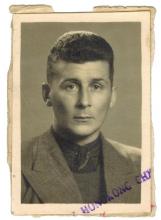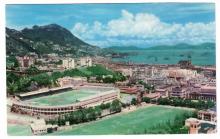Yuri Vitalievitch SMIRNOFF (aka George) [1903-1947]
Primary tabs
Yuri Smirnoff left Russia with his mother at the start of the Bolshevik revolution. They moved to Harbin in northern China, where he qualified as an architect. He also married: Nina Pleshakoff. Irina, their first child, was born in 1934. He came to Hong Kong in 1937 - via Tsingtsao - a common route for Russian emigres responding to Japanese actions in north China. In 1941 he was working as an architect for the firm of Marsman and Co. on the Air Raid Precautions scheme.
In the first year of the Japanese occupation he was employed to produce murals for the Japanese Public Works Scheme but was told his heart was not in it - which was true as he devoted most of his time to music and sketching in the office provided. He was suspected of spying by the Kempeitai and his home (near the Police Training School on Nathan Road) searched a number of times. When illegal liquor (a few bottles of home-made vodka) was found, he spent a short time in Stanley Prison, meeting some of those later executed for espionage. He was released under an amnesty and decided to leave for Macao with Irina. This seems to have been in late 1943 or early 1944 as he was 'bombed out of his house' when it was hit during an American air raid of Tsimshatsui on December 1, 1943.
He left behind him cartoons of various Japanese officials which were sometimes left conspicuously in public places as acts of resistance.
His wife, Nina, stayed behind in Hong Kong with their second daughter, also Nina, and their young son, Alexander. They eventually joined him in Macao.
While working to support himself in Macao, he also found time to paint, and he is now considered one of the most distinguished painters of the territory.
He returned to Hong Kong in October 1945 to work for the Public Works Department.
Sources:
http://www.arscives.com/gsmirn/artist.htm
Hong Kong Sunday Herald, October 28, 1945, 3
Jurors List for 1941
https://books.google.co.uk/books?id=iaZMzPuLAggC&pg=PA529&lpg=PA529&dq=g...
- Yuri Vitalievitch SMIRNOFF (aka George) [1903-1947] spouse of Nina SMIRNOFF (née PLESHAKOFF) [????-????]
- Yuri Vitalievitch SMIRNOFF (aka George) [1903-1947] member of Russian community in Hong Kong [????- ]
- Yuri Vitalievitch SMIRNOFF (aka George) [1903-1947] parent of Irene SMIRNOFF GARFINKLE [????- ]



Comments
George Vitalievich Smirnoff
For the record, George Vitalievich Smirnoff was born on 27 October 1903.
It hardly matters now, but my father was never known as Yuri. Yuri is just the Russian form of George. Because so many thousands of Russians were refugees fleeing the USSR when he was young, they all spoke to each other in Russian. As the refugees moved around they picked up other languages and, as you know, in Hongkong at that time it was strictly survival time.
George Smirnoff was buried in Hongkong. His grave is at the Happy Valley Cemetery very close to the entrance. It has an approx. 4 ft tall Russian cross. The stone is of white marble but I'm told it has become quite weathered.
Gravestone
He is buried in section 13 of the cemetery, plot 13---/02/07-. The inscription on his gravestone reads:
GEORGE VITALIEVICH
SMIRNOFF
Born 27-10-1903
Died 6-2-1947
<Russian script.>
HK Marble Co. #10363
There are photos at: http://www.findagrave.com/cgi-bin/fg.cgi?page=gr&GSln=smirnoff&GSiman=1&...
During 1944-1945, George and
During 1944-1945, George and his family left Hong Kong for the relative safety of Macau. While in Macau he painted a series of watercolours.
There was an exhibition of his paintings to celebrate the 100th anniversary of his birth, and the writeup has more information about him and his background: http://www.mam.gov.mo/oldmam/shows/smirnoff/english/safeharbour_e.htm
His daughter Irene has also written about those years at: http://gwulo.com/node/35127
Irene: thanks for this
Irene: thanks for this information and sorry I missed your comment. I've now made some changes in line with what you tell us.
George Smirnoff
My husband's uncle was a student of your father and went on to teach in Porto, Portugal. We have a small watercolor of your father's from Macau. Luis Demee.
George Smirnoff
The first article says that the Smirnoff home was "bombed" perhaps in 1943. Actually, I am pretty certain that it was the very first American air raid on Hong Kong during the War which occurred on the 25th October, 1942. By a strange coincidence, my elder brother and I were visiting the two Smirnoff girls, Irina and Nina, when that air raid took place. The Smirnoffs lived on the top 3rd floor of an apartment building which had six apartments. There was a dividing wall between the 6 flats, and the building had two entrances. During the air raid, we heard lots of bombs whistling down before exploding. Then we heard a bomb whistling down, but instead of an explosion there were several loud thumps. That was a 500 lb bomb hitting the roof of the adjoining section of the building, and then crashing down several floors before landing on the ground floor, WITHOUT exploding. It lay there just a few feet away from us on the other side of a thin dividing wall. Several days after the air raid, I went back to the site and managed to sneak past the Japanese sentries and had a look at that bomb lying on its side. It looked pretty ugly to me!